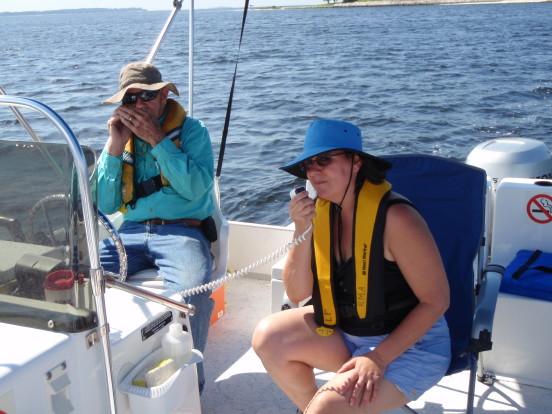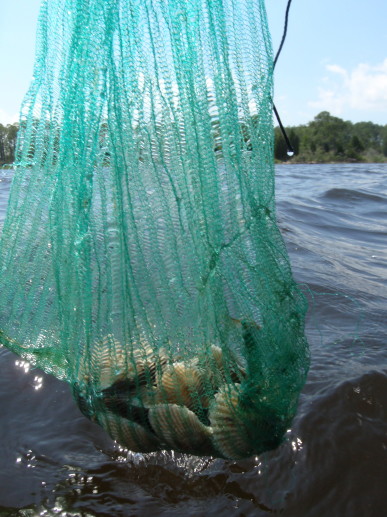Replenishing St. Andrews Bay, Florida Gulf Coast, with native scallops, May 16, 2009
By Linda MuellerThere are 5 pictures, a link to the News Herald photo gallery that you can play as a slideshow, and 2 video links (just ignore them if your internet connection won't support playing videos.)
Plus, a bonus 6th picture of Linda canoeing! Well, wading!
Except for this first scallop picture, you can see bigger versions of the pictures by clicking on the picture.

-
Dr. Kerley, the president of GCCC, is going to interview me and
Melissa Moore, my colleague, on Friday about the project. He has a
show called College Talk and the interviews air on our local GCCC
channel on some random schedule. I've already been on for
international programs, so now I will be on for scallops. This is my
15 milliseconds of fame. (Actually there are 4 pictures on this website, a link to a photo gallery and links to two videos that you can ignore if you setup doesn't support showing video.)

Linda says: I went out into the bay yesterday to release the scallops that we had been growing in cages at the end of the marine fisheries dock since January and some reporters came with us. So I am on the front page of the News Herald today and there is a small blurb giving our environmental group, the St. Andrew Bay Resource Management Association, some much needed publicity. (Most people in town still have not heard of us although the group has been doing water quality monitoring since 1990....)

Gulf Coast students growing scallops to increase survival rate
May 12, 2009 04:00:00 AM
By MATT DIXON / News Herald Writer
Photo Gallery: News Herald photo gallery (12 pictures) Video: News Herald video (2 minutes 21 seconds)PANAMA CITY - Their day began in a large plastic garbage can, tucked away in 17 citrus bags. It ended with a brief boat ride and a return trip to St. Andrew Bay.
Linda Fitzhugh and her Gulf Coast Community College class released about 450 scallops Monday morning as part of a project to repopulate the bay's scallops.
"Right now the population is low," Fitzhugh said. "Our ultimate goal is to increase the population so we can scallop right here."
The project began in January when Fitzhugh collected scallop spat, or baby scallops, with the intent of allowing them to grow in captivity to to a size that would keep them safe from natural predators.
"We want to protect them from predation," Fitzhugh said. "There are a lot of things that will eat them when they are small."
Predators include lobsters, crabs and sea stars.
After a 20-minute boat ride to waters near the airport, the soggy green citrus bags that served as temporary homes to the scallops were lifted from a large blue garbage bin. One by one the tiny creatures were returned to the body of water from which they came four months ago.
"Look at their eyes," 21-year-old biology student Kelley Brannon said as he inspected a handful of scallops before tossing them in the water. "You wouldn't think something like this would have such blue eyes."
Fitzhugh said this was only the first round; the process will take place again next year. Anyone with a pier can help, Brannon said.
"We are really looking for the public to take part next time; it's part of our plans" Brannon said.

Background:K. J. Starzinger received a request from the Florida Marine Research Institute (MRI) in 2004 to help the State of Florida monitor scallops in St. Andrew Bay. MRI's Dr. Steve Geiger, helped RMA submit a proposal for funding the same year which began a partnership with the goal of restoring scallops in the bay. MRI is a facility of the Florida Fish and Wildlife Conservation Commission (FWC)
Dr. Geiger set up RMA with spat ng supplies and Chris Metcalf volunteered to head up the monitoring. MRI has monitored scallops in West Florida since the mid-1990's.
Our first stocking in the St. Andrew Bay occurred in 2005? (Chris, is that the year?) when Dr. Geiger took spat from St. Joe Bay to a rearing facility in St. Petersburg; then stocked these scallops in St Andrew Bay. Red tide hit the area within a couple of weeks, and we suspect these scallops were mostly eliminated. Dr. Geiger is interested in promoting scallop restoration as a community participation project, where RMA will harvest scallop spat and place them in cages which would be attached to volunteer pier sites in suitable locations for rearing.

Scallops Released Into St. Andrew's Bay After Being Raised by Environmental Group
Panhandle Parade, May 11, 2009
By Erin Hawley, ehawley@wmbb.com
Video (2 minutes):A local volunteer group works to repopulate St. Andrew's Bay with scallops. Nearly four months after harvesting the baby scallops, called spat, members of the St. Andrew Resource Management Association's Scallop Restoration Group released almost 500 adults back into the bay.
Members of the group harvested the spat back in January and took them to the Marine Fishery to be raised in a protected environment.
They hope the new initiative will increase the population enough that one day the area will be able to return to scalloping.
Linda Fitzhugh, a Gulf Coast Community College marine biology professor, and several students took on scallop-raising as a new project this semester.
"We wanted to start a community based project where we raised scallops in cages off of docks," Fitzhugh says.
Kelley Brannon, a marine biology student, says the class has been involved in checking the spat since January.
"We went out in about two to three weeks intervals," Brannon explains, "Going and checking on the different growth rates and cleanliness of the cages and things."
They originally collected the spat from three areas in the bay.
"We're using scallops that have been caught here, the little spat, they're very, very small about the size of a dime or nickel," Fitzhugh says, "And then we're growing them out and putting them back in the bay when they're bigger."
The scallops have grown from 15 millimeters all the way up to 45 millimeters.
"The coolest thing about it would probably be just seeing them grow up," Brannon says. "It sounds kind of corny but they almost seem like our children. We watched them grow from tiny things and we had to watch them go."
The group carefully checked to make sure each scallop was alive, finding only two of nearly 500 that didn't survive. That number would have been much higher had the spat been left to grow in an unprotected environment.
Linda is heading up this volunteer effort, but we need to expand the project to increase the numbers of scallops reared. Our scallop project is operated under a Florida Special Activity License issued to RMA. Since scallops are a regulated species, any handling of the scallops will need to be under a permit issued by the FWC.
If you have any questions about RMA's scallop project, please see Chris, Linda or me. Jim
Erin Hawley - bio ehawley@wmbb.com
 And for a non-scallop-related shot!
And for a non-scallop-related shot!
Here I am (with Dan Hudson in the background) in the upper Econfina creek. We were finally able to canoe this stretch of water after two years of waiting. Why did we have to wait? Well with the drought the water levels were too low, but we have gotten enough rain this year to bring the water levels up enough. This stretch of the creek has limestone shoots; I feel like I am in a summer luge of some sort. It's fun. It's warm here. Gary and I are doing chores. I need to hack the blackened caulk out of the shower and recaulk. Fun, fun, fun. Then I get to scrub the tub in the other bathroom. Whew - I just can't wait to get started. How did your flower arranging go? What are you doing this weekend? I hope something a bit more enlightening than hacking mildewed caulk out of your shower area. Hugs, kisses, and best wishes, Love,
Marianne Mueller, mrm@sonic.net
Created May 16, 2009